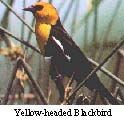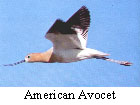Bulletin Board
April 5, 2000
|
|
|
|
There is a growing appreciation for wetlands. A wetland acts like a filter, removing sediment and toxic chemicals contaminating water. During times of storms and high water, wetlands reduce the risk of flooding by absorbing and holding water, which is slowly released during periods when water is scarce. Wetlands also provide recreational activities, such as bird watching. Wetlands are a very important part of our ecosystem, which must be protected. They provide habitat for a wide variety of wildlife and vegetation.
The
official planning of the “Wetlands Project” at the Salt Lake City Water
Reclamation Plant began in October of 1987. Organizations involved in its
creation included Salt Lake City, Salt Lake County, Army Corp of
Engineers, Division of Environmental Quality, Division of Wildlife
Resources, Salt Lake City Mosquito Abatement, United States Fish and
Wildlife Service, and the Audubon Society. Construction began in 1989 and
was completed in 1990, at an investment of around $200,000.

The project covers an
approximate forty-acre plot of land and consists of about a mile and a
quarter of free flowing channel, with water depths at some places in
excess of three feet. The water surface area is roughly one third of the
total plot, with average daily flow of around three million gallons of
treated reclamation plant effluent traversing the site.
Golden
Eagle

The site includes a dedicated discharge point by “UPDES permit” issued by the State of Utah Department of Environmental Quality. The water from the wetland is held to the same water quality standard as the reclamation plant effluent.
The
abundance of bulrush, cattail, reed and other grass species provide
habitat for many forms of life, ranging from the smallest meadow vole, and
deer mouse, to muskrat, weasel, skunk, raccoon, and red fox. According to
Jon Adams, Reclamation Manager, the wetlands management plan provides
balance between the various predators and other wildlife. “Except, we do
trap and humanely remove feral cats which, because of their numbers
unbalance nature’s way,” explains Adams. “Otherwise we let nature
prevail.” The only exception is during the nesting period, when
Reclamation Plant personnel are careful in the way they maintain the
wetlands with equipment and flow changes. “The operators are careful not
to disturb the nesting waterfowl,” Adams joking exclaims, “Our
maternal instincts kick in during this period and it’s with great
satisfaction when the eggs hatch and there is new life in the
wetlands.”

|
|
|
|
To accommodate the public, there is a large parking area outside of the facilities’ north fence line. During the day, a handicap access observation deck is located just off the Administration building parking lot. “The public is invited to the wetlands to enjoy this community amenity,” says Adams. He notes, “Many from the adjoining neighborhood take their daily walk through the wetlands to enjoy its environmental ambiance.”
In addition to providing needed wetlands for bird migration and habitation, the site provides a research area for diverse fields of study, including but not limited to horticultural, biological, ornithological, and environmental protection. The area has added a pleasing quality to Salt Lake City’s Reclamation facility.
Questions regarding this article can be directed to: jon.adams@ci.slc.ut.us or dale.christensen@ci.slc.ut.us



